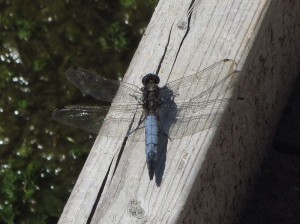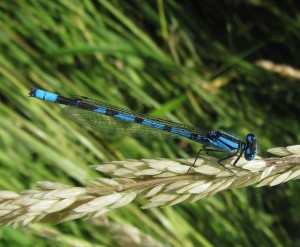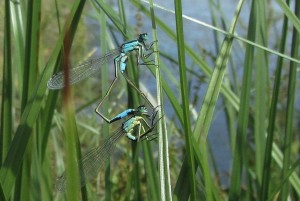Small Red-eyed Damselfly (Erythromma viridulum) was found at Crossness Southern Marsh (part of the remnant of Erith Marshes) on yesterday’s LNHS invertebrate meeting, a new site record, taking the Odonata species total here to 15 (though no one seems to have seen an Emerald Damselfly lately). The species was flying in substantial numbers at both the board-walked ‘teapot’ pond, and the wader scrape at the east end of Southern Marsh, and was also mating, suggesting pioneer individuals probably showed up here last year, but went unnoticed. I had been expecting (Large) Red-eyed to show up first, and on reaching the pond via the main raised pathway, it looked from a distance as if at least one of the Damselflies on the mats of floating algae was one of the Red-eyed species. Second on the scene was Mick Massie, who thought the behaviour did indeed look like a Red-eyed. Close views were had from the boardwalk itself and I was quickly able to confirm Small Red-eyed by the blue under the 8th segment (third from the tail end) and the ante-humeral stripes on the black of the thorax.
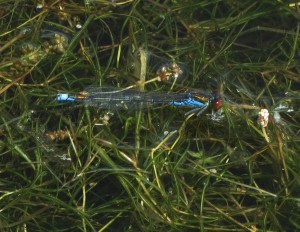
New site record: a Small Red-eyed Damselfly at Crossness, showing the key distinguishing features, which include the black ‘X’ at the tail end. (Photo: Purnendu Roy).
Attendees were also treated to Common Blue Damselflies, Blue-tails, aerial clashes between a male Black-tailed Skimmer and the recent site ‘re-discovery’ in Four-spotted Chasers, a patrolling male Emperor and egg-laying female Emperor.
Mick Massie got an excellent photo of a female Ruddy Darter on Southern Marsh, later confirmed online by LNHS Odonata expert Roy Woodward.
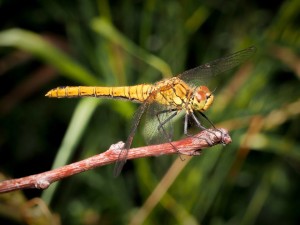
Female Ruddy Darter (Sympetrum sanguineum) at Crossness. The all-black legs with no yellow stripe help separate this species from Common Darter. (Photo: Mick Massie).
There was a strong turnout of 27 people for this event, comprising Friends of Crossness Nature Reserve, one of the Ruxley Gravel Pits volunteers, several people from Lesnes Abbey Conservation Volunteers, as well as the London Natural History Society contingent from further afield. Useful contacts were made between people who had not met before whilst others who lived nearby had not previously been aware of the existence of this fabulous site. A fuller report will follow once the task of identifying some of the smaller invertebrates has been completed.
Chris Rose

